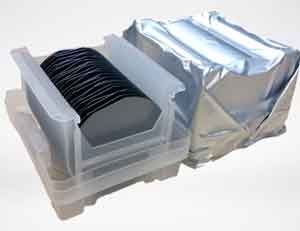Order More. Save More. Ask about our bulk wafer pricing today.
Call: 1-800-713-9375
Order today and receive a free consultation from our experts.
SOI Research Quick Facts
- SOI wafers reduce power consumption by 15–20%
- Enable 20–35% faster operation speeds than bulk Si
- Device layer thickness: 5 nm – 1.5 μm
- Buried oxide (BOX) thickness: 25 nm – 3 μm
- Available diameters: 100mm, 150mm, 200mm, 300mm
Why Researchers Choose SOI
SOI wafers provide full dielectric isolation, radiation hardness, and superior high-frequency performance—ideal for CMOS, MEMS, photonics, and RF research.
Application-Specific Notes
- CMOS: Ultra-thin device layers prevent short-channel effects
- MEMS: Thicker layers (1–20 μm) support mechanical structures
- Photonics: High-resistivity layers reduce optical losses
- Radiation-Hardened: Optimized BOX improves reliability in space/nuclear environments
Explore More
Best SOI Wafers for Semiconductor Research: Complete Guide
Key Takeaways
- SOI (Silicon-On-Insulator) wafers consist of three layers: silicon device layer, insulator layer, and silicon base
- SOI technology offers superior performance with 15-20% lower power consumption and 20-35% faster operation speeds
- Manufacturing methods include SIMOX, wafer bonding, Smart-Cut technology, and ELTRAN
- Applications span advanced ICs, telecommunications, aerospace, MEMS, and high-performance computing
- Despite higher initial costs, SOI wafers provide significant performance advantages that often justify the investment
- Customization options are available for specific research requirements
- Ultra-thin SOI wafers enable fully depleted device architectures for next-generation electronics
- Advanced characterization techniques are essential for evaluating SOI wafer quality
- Thermal management solutions can mitigate self-heating effects in SOI devices
- Emerging variants include GeOI and III-V on insulator for specialized applications
Introduction to SOI Wafers in Semiconductor Research
Silicon-On-Insulator (SOI) technology represents one of the most significant advancements in semiconductor manufacturing. Unlike conventional silicon wafers, SOI wafers feature a specialized three-layer structure that delivers substantial performance improvements for modern electronic devices and research applications. This technology has transformed the semiconductor landscape by enabling devices with enhanced speed, reduced power consumption, and improved isolation characteristics that are critical in today’s advanced electronic systems.
SOI wafers consist of three distinct layers: a thin silicon device layer where active components are fabricated, an insulating layer (typically silicon dioxide, also called buried oxide or BOX), and a silicon handle or substrate that provides structural support. This unique structure fundamentally changes how electronic devices function by providing complete dielectric isolation between components, effectively eliminating parasitic capacitances and leakage currents that typically limit conventional semiconductor performance...
Understanding SOI Wafer Structure and Composition
The Three-Layer Configuration
1. Silicon Device Layer: This topmost layer is where active semiconductor devices are fabricated...
2. Buried Oxide (BOX) Layer: The middle insulating layer, typically composed of silicon dioxide (SiO₂), provides electrical isolation...
3. Silicon Handle/Substrate: The bottom layer provides mechanical support for the entire structure...
Critical Specifications and Parameters
- Device Layer Thickness: Typically ranges from 5nm to 1.5μm depending on application...
- Device Layer Resistivity: Can be tailored from 0.01 to 100 Ω-cm based on doping concentration and type...
- BOX Layer Thickness: Usually between 25nm and 3μm...
- Surface Finish: Ultra-smooth surfaces with roughness less than 0.2nm RMS are typically required...
- Diameter: Available in standard sizes (100mm, 150mm, 200mm, 300mm)...
- Crystal Orientation: Typically <100> or <111>, with the choice affecting carrier mobility...
- Doping Type: P-type (boron) or N-type (phosphorus, arsenic)...
Manufacturing Methods for High-Quality SOI Wafers
SIMOX (Separation by Implantation of Oxygen)
The SIMOX process involves implanting a high dose of oxygen ions into a silicon wafer, followed by high-temperature annealing...
Wafer Bonding and Layer Transfer Techniques
1. Bond and Etchback SOI (BESOI)
This method involves bonding two oxidized silicon wafers together, then thinning one wafer through mechanical grinding and chemical etching...
2. Smart Cut™ Technology
The Smart Cut process combines wafer bonding with hydrogen implantation to achieve precise layer transfer...
3. ELTRAN (Epitaxial Layer Transfer)
ELTRAN combines epitaxial growth, porous silicon formation, and wafer bonding to create SOI wafers with exceptional device layer quality...
Performance Advantages of SOI Wafers in Research Applications
Enhanced Electrical Performance
1. Reduced Parasitic Capacitance
The buried oxide layer in SOI wafers significantly reduces junction capacitances compared to bulk silicon...
- 20-35% faster switching speeds
- 15-20% lower power consumption
- Improved high-frequency performance
2. Complete Dielectric Isolation
Each device on an SOI wafer is completely isolated from neighboring devices...
3. Improved Subthreshold Characteristics
SOI transistors exhibit steeper subthreshold slopes and reduced threshold voltage variations compared to bulk devices...
Thermal and Environmental Advantages
1. Radiation Hardness
The thin silicon device layer and buried oxide structure make SOI devices inherently more resistant to radiation effects...
2. Temperature Range Tolerance
SOI devices typically operate over a wider temperature range than conventional bulk silicon devices...
3. Reduced Temperature Sensitivity
The isolation provided by the buried oxide layer reduces leakage current temperature dependence...
Selecting the Right SOI Wafers for Your Research
Key Parameters to Consider
When selecting SOI wafers for research applications, several critical parameters must be evaluated...
1. Device Layer Specifications
- Thickness: Ultra-thin (<50nm), moderate (50-200nm), or thick (>200nm)...
- Resistivity: High resistivity for RF/Photonics, moderate for CMOS, low for power...
- Crystal Orientation: Typically <100> for CMOS, <110> or <111> for specialized research...
2. Buried Oxide (BOX) Layer Properties
- Thickness: Thinner BOX for thermal conductivity, thicker for isolation
- Quality: Defect density, uniformity, and breakdown characteristics
3. Handle Wafer Characteristics
- Thickness: Standard (500–750μm) or thinned
- Resistivity: High for RF to minimize substrate losses
- Backside Treatment: Polished, etched, or coated
Application-Specific Considerations
For Advanced CMOS Research
Ultra-thin, uniform device layers are essential to maximize electrostatic control and minimize short-channel effects. Precisely controlled BOX thickness is needed to balance isolation and thermal management. Excellent interface quality and low defect density ensure reliable transistor operation. Specialized FinFET SOI wafers offer the specifications required for cutting-edge CMOS research.
For MEMS/Sensor Development
Thicker device layers (1–20μm) provide enough material for mechanical structures. Good thickness uniformity ensures consistent mechanical properties. Thicker BOX may be desirable for isolation and sacrificial layers in release processes. Handle wafer properties influence stability and compatibility with deep etching.
For Photonics Research
Ultra-high device layer resistivity minimizes optical absorption losses. Exceptional surface smoothness reduces scattering. Precise thickness control ensures correct optical modes. Low defect density helps improve optical transmission.
For Radiation-Hardened Applications
Optimized BOX thickness balances radiation tolerance with device performance. High-quality oxides minimize charge trapping. Thinned device layers improve full depletion and enhance radiation hardness.
Quality Assurance Considerations
- Surface Quality: RMS roughness typically <0.2nm
- Thickness Uniformity: ±5% or better
- Defect Density: Evaluated with optical/etch testing
- Edge Exclusion: 3–5mm typically not guaranteed
Working with reputable suppliers who provide detailed specifications and quality assurance documentation is essential for success. Many offer consultation services to guide wafer selection for specific applications.
SOI Wafer Applications in Advanced Semiconductor Research
Advanced Logic and Computing Research
1. Low-Power Processor Research
Reduced parasitic capacitance and improved subthreshold characteristics make SOI ideal for ultra-low-power computing architectures. Benefits include near-threshold computing, energy-harvesting systems, IoT processors, and edge computing solutions. Typical power reduction: 15–20% compared to bulk silicon.
2. High-Performance Computing
SOI wafers enable higher clock frequencies (20–35% faster), reduced signal latency, better noise isolation, and optimized thermal design. This makes them suitable for exascale computing, AI accelerators, and advanced processors.
RF and Analog/Mixed-Signal Research
1. RF Circuit Development
SOI reduces substrate coupling and crosstalk, lowers parasitic capacitances, and enables better RF performance. High-quality passives and improved linearity benefit wireless communication and 5G/6G technologies.
2. Analog and Mixed-Signal Circuits
SOI wafers provide better isolation between analog/digital domains, reduced substrate noise, improved matching, and enhanced performance at lower voltages. Researchers leverage these advantages for next-generation data converters, sensors, and precision analog ICs.
Emerging Technologies and Novel Devices
1. Quantum Computing Components
SOI wafers aid in spin qubits, quantum dots, cryogenic control electronics, and superconducting qubit interfaces, where isolation and low parasitic effects are critical.
2. Neuromorphic Computing
SOI supports synaptic device arrays, low-leakage memory elements, analog computing, and 3D neural integration. Reduced leakage and isolation are particularly valuable for brain-inspired architectures.
Specialized Application Domains
1. Radiation-Hardened Electronics
SOI is used for space electronics, nuclear instrumentation, high-energy physics, and medical radiation equipment due to inherent radiation resistance.
2. High-Temperature Electronics
SOI operates at elevated temperatures (200°C+), enabling downhole oil/gas electronics, jet engine control, industrial process monitoring, and automotive systems. Reduced leakage and stability at high temperatures expand the usability of silicon-based electronics.
Technical Challenges and Solutions in SOI Wafer Research
Thermal Management Challenges
The buried oxide (BOX) has ~100× lower thermal conductivity than silicon, which can cause self-heating in active devices. Effects include higher local temperatures, threshold shifts, increased leakage, and reliability concerns.
Solutions
- Body contacts/heat spreaders: Add thermal paths through the BOX.
- Thermal-aware layouts: Distribute heat sources to reduce hotspots.
- Dynamic management: Power control to prevent thermal runaway.
- Novel BOX materials: Use higher thermal conductivity composites.
- 3D integration: Through-silicon vias (TSVs) for direct heat sinking.
Floating Body Effects
The isolated body can accumulate charge, leading to threshold variability, kink effect, parasitic conduction, and memory effects.
Solutions
- Implement body ties for defined potential
- Use fully depleted SOI to eliminate floating regions
- Adopt circuit designs less sensitive to body effects
- Optimize biasing to minimize parasitic behavior
Cost Considerations
SOI wafers cost 2–5× more than bulk wafers. Optimization strategies include right-sizing specs, collaborative purchasing, phased research, and multi-project wafers.
Quality Assessment and Characterization
- Thickness: Ellipsometry, FTIR, cross-sectional SEM
- Interface quality: C–V, conductance, pseudo-MOSFET
- Defect analysis: Light scattering, etching, photoluminescence
Reputable suppliers provide characterization data and technical support, ensuring materials meet research goals.
Future Trends and Emerging SOI Technologies
Ultra-Thin SOI and FD-SOI
Sub-10nm device layers enable fully depleted operation, reduced variability, better scaling, and improved energy efficiency.
Novel SOI Variants
GeOI (Germanium-on-Insulator)
Germanium wafers provide higher mobility for high-speed CMOS, IR photonics, and advanced analog devices.
III-V on Insulator
Compound semiconductors on insulators enable ultra-high-frequency RF, optoelectronics, and efficient power devices.
Advanced Integration Approaches
- Multi-layer SOI for 3D integration
- Selective area SOI for specialized regions
- Engineered substrates with tailored properties
Conclusion
SOI wafers are essential for advanced semiconductor research, offering 20–35% faster speeds, 15–20% lower power consumption, full dielectric isolation, and radiation hardness. These features support applications in CMOS, MEMS, photonics, RF, and extreme environments.
Key Research Enablers
- Enhanced isolation for SoC integration
- Reduced parasitic effects for high-frequency/low-power designs
- Radiation tolerance for aerospace and nuclear applications
- Thermal properties managed with design strategies
- Scalability for continued miniaturization
Looking Ahead
Future SOI development will include ultra-thin FD-SOI, GeOI, III-V integration, and engineered substrates. These trends align with quantum computing, neuromorphic systems, and extreme-environment electronics. SOI wafers provide researchers with a robust platform for innovation beyond the limits of bulk silicon.
Our SOI wafer solutions support researchers worldwide with high-quality materials, precise specifications, and technical expertise to accelerate semiconductor discoveries.

